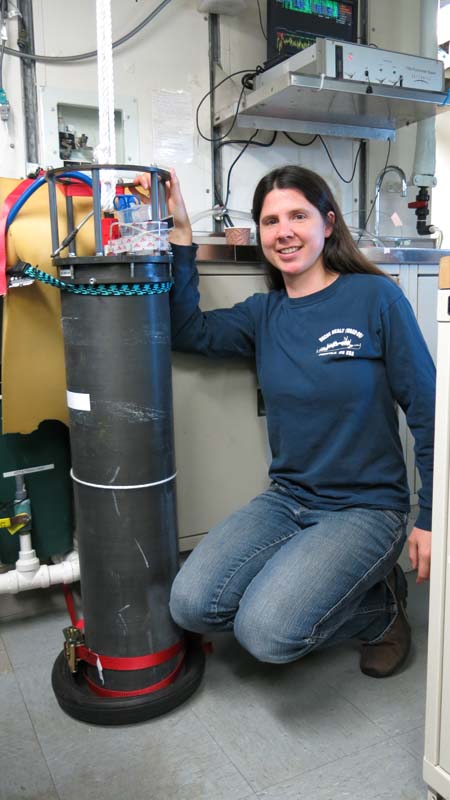NOAA Teacher at Sea
Dieuwertje “DJ” Kast
Aboard NOAA Ship Henry B. Bigelow
May 19 – June 3, 2015
Mission: Ecosystem Monitoring Survey
Geographical area of cruise: East Coast
Date: May 25, 2015, Day 7 of Voyage
Interview with Emily Peacock

Emily Peacock is a Research Assistant with Dr. Heidi Sosik at the Woods Hole Oceanographic Institution (WHOI). She is using imaging flow-cytometry to document the phytoplankton community structure along the NOAA Henry B. Bigelow Route.
Why is your research important?
Phytoplankton are very important to marine ecosystems and are at the bottom of the food chain. They uptake carbon dioxide (CO2) and through the process of photosynthesis make oxygen, much like the trees of the more well-known rain forests.

The purpose of our research is “to understand the processes controlling the seasonal variability of phytoplankton biomass over the inner shelf off the northeast coast of the United States. Coastal ocean ecosystems are highly productive and play important roles in the regional and global cycling of carbon and other elements but, especially for the inner shelf, the combination of physical and biological processes that regulate them are not well understood.” (WHOI 2015)
What tool do you use in your work you could not live without?
I am using an ImagingFlowCytobot (IFCB) to sample from the flow-through Scientific Seawater System.



IFCB is an imaging flow cytometer that collects 5 ml of seawater at a time and images the phytoplankton in the sample. IFCB images anywhere from 10,000 phytoplankon/sample in coastal waters to ~200 in less productive water. Emily is creating a sort of plankton database with all these images. They look fantastic, see below for sample images!


Photo Credit: IFCB, from this Henry Bigelow research cruise.
The IFCB “is a system that uses a combination of video and flow cytometric technology to both capture images of organisms for identification and measure chlorophyll fluorescence associated with each image. Images can be automatically classified with software, while the measurements of chlorophyll fluorescence make it possible to more efficiently analyze phytoplankton cells by triggering on chlorophyll-containing particles.” (WHOI ICFB 2015).
What do you enjoy about your work?
I really enjoy looking at the phytoplankton images and identifying and looking for more unusual images that we don’t see as often. I particularly enjoy seeing plankton-plankton interactions and grazing of phytoplankton.
Grazing (all photo examples are not from this research cruise but still from an IFCB):




What type of phytoplankton do you see?
I am seeing a lot of dinoflagellates in the water today (May 20th, 2015), Ceratium specifically.

The most common types of plankton I see are: diatoms, dinoflagellates, and microzooplankton like ciliates. The general size range for the phytoplankton I am looking at is 5-200 microns.

Where do you do most of your work?
“The Martha’s Vineyard Coastal Observatory (MVCO) is a leading research and engineering facility operated by Woods Hole Oceanographic Institution. The observatory is located at South Beach, Massachusetts and there is a tower in the ocean a mile off the south shore of Martha’s Vineyard where it provides real time and archived coastal oceanographic and meteorological data for researchers, students and the general public.” (MVCO 2015).

Most of my work with Heidi is at the Martha’s Vineyard Coastal Observatory. IFCB at MVCO has sampled phytoplankton every 20 minutes since 2006 (nearly continuously). This unique data set with high temporal resolution allows for observations not possible with monthly or weekly phytoplankton sampling.
Below is an example from the MVCO from about an hour ago at 1 PM on May 20th, 2015.

Did you know??
IFCB at Martha’s Vineyard Coastal Observatory has collected photos of nearby phytoplankton every 20 minutes since 2006 (9 years, almost continuously). With this time series, you can study changes in temporal and seasonal patterns in phytoplankton throughout the years.
Helpful Related links:
Current Plankton at the MVCO: demi.whoi.edu/mvco

